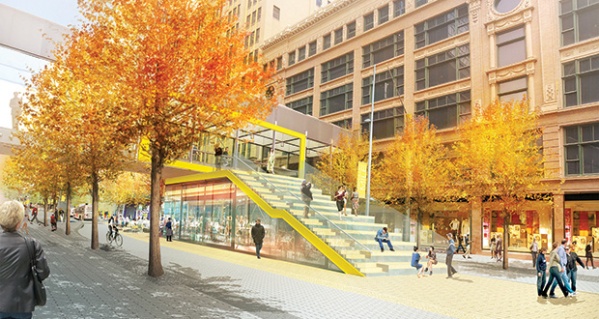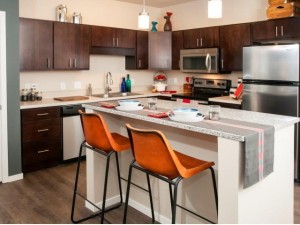When John and I moved to the edge of downtown Minneapolis in the fall of 2013, I was shocked at what we found there. The area was fast becoming a ghost town, with retail stores shuttered and some of the mainstay restaurants we were familiar with, sitting empty.
Only eight years prior, I had been working in the center of downtown for a nonprofit, connected to the Minneapolis Public Works department, focused on helping downtown Minneapolis businesses thrive through behavior change methods related to multi-modal transportation options. In short, it was my job to get employers excited about encouraging their employees to get to work in ways that didn’t involve driving a car into downtown alone: car/vanpooling, bicycle commuting, and taking transit. My service was funded by a federal congestion mitigation grant, and was doing some important, effective work to limit ozone emissions.
My job took me through the downtown skyways and office towers several times each business day, for meetings, commuter fairs and other functions, while I served the needs of more than 250 employers with whom we had built relationships. Avoiding the skyways during the noon hour, I learned that it was too congested to make it to my appointments on time. due to the elbow-to-elbow congestion. The retail stores were so prolific, and tempting, in those days. I set a weekly spending limit for myself to stay within my budget.
This downtown neighborhood had been even more robust when I was a child in the 60’s and ’70s, when my mother took me shopping in the “big city” from our nearby rural Wisconsin home. The street scene on the Mall was always busy and populated with business people in suits and shoppers like ourselves. Dayton’s (now Macy’s) was THE premiere store and there was almost a hushed, museum-like quality when we walked by the Oval Room or had lunch into the Oak Grill.
Walking down Nicollet Mall in November of 2013, thinking I would be walking back into the hustle and bustle of the holiday season I had seen in 2005, I was stunned to witness that downtown Minneapolis was beginning to look a lot like the vacant downtown St. Paul from which John and I had just moved. Granted, we had come to accept that all neighborhoods change and that, at times, they don’t change into what works for you, so you move on. But I was truly worried about the abandonment of what I had always found to be a vital and lovely urban center.
Feeling safe on Nicollet Mall quickly became a memory as I found myself dealing with panhandlers whose bold approach rivaled those I had encountered in other major cities. Shouting matches and physical fights broke out around me so routinely on the Mall that I found it was easier to simply walk through the skyways to reach places like Target and Macy’s.
I was worried. Had we made the right move here? Giving up a car and moving into a smaller apartment to simplify our lives by being closer to more retail and public transit options? The retail was fast disappearing. Frustration set in when Office Depot closed and I was back to ordering supplies for my office online. Public transit was plentiful, but not as safe as it had felt when I last worked downtown.
When I heard of City of Minneapolis’ and Mayor Betsy Hodges’ ideas to transition downtown from an employment center into an urban neighborhood, I was excited. Not only did the plan make sense to me from the standpoint that it would buoy our urban center, it posed an exciting prospect for individuals in a world where resources are shrinking.
The “land use” geek inside of me, fostered by the years I worked on transportation initiatives for the City of Minneapolis and

Though we don’t live here (yet…) the Nic on 5th in the heart of downtown has some very cool shared amenities on their rooftop including fire pit and hot tub. Best part? We can spend our money on starting a mission-based business and get to use amenities like this because we’re willing to share!
Minnesota State DOT, fueled thoughts in my head about people finally “getting” the practical, and flat-out FUN value of living together in less space. The idea of moving people closer together so that they can share resources more effectively isn’t a new one. But it is one that can free people up to live less complicated, richer lives. Being a mother who raised a daughter as a single parent, and someone who has always sought jobs that had a higher “paycheck of the heart” than cash value, it had always been easy for me to see how each of us could have MORE by living with less and sharing what we have.
Urban living, in either apartments or condos, allow people to pay for less while having more. Smaller homes mean less furniture, lower utility bills and less to keep clean. Building amenities, like the patio with gas grills and fire pit, fitness center and well-appointed community room and kitchen, which John and I share with our neighbors at the Grain Belt, give us access to luxuries we may not have be able to afford on our own. (HINT: apartment living gives you the freedom to try out new buildings and areas too!)
Perhaps what I love most about this kind of urban living is what occurs when you share space and resources with your neighbors. We’ve met so many people of ages and backgrounds very different from our own, over the BBQ grill, in the elevators or taking in the Tour de France via the TV in the community room, in the buildings we’ve lived in. Friendships have been formed and our lives have been fuller, and more fun, as a result. So much so, it’s hard for me to even entertain going back to living in a single family home.
Living without a car took some getting used to, but we find it’s easier to share short-term use SmartCars with our neighbors and take advantage of free parking on the city’s streets. (See Car2Go Twin Cities.) We also love the fact that we get to drive premium vehicles we don’t have to worry about maintaining, for out-of-town trips, visiting relatives or just seeing fall colors. (See HourCar.) AND we love supporting mass transit by taking the bus or the train, making it possible for others who can’t afford cars to get around, who those who chose to bolster our environment or simply want to spend their money in other ways. (See Metro Transit.)
Our suburban friends say they don’t get it. “How could you live that close to other people?” “Where do you put all of your stuff?” or “I need to know I can jump in my car and go where I want when I want!” is what we often hear from them. Then, quietly, when none of our other suburban friends are in earshot, they’ll say, “Your apartment looks awesome and you seem so happy. I would LOVE to unload the house and all the junk we’re hanging on to and do what you did!”
It’s not rocket science: when you have less stuff to store, keep up and pay for, life gets simpler. John and I made this choice partly because being single parents positioned us to be good at it before we met, and partly because we saw the value to continue in that direction with our life choices as a married couple.
Everyone’s needs are different, and so their choices must be too. But doing it together with less, can be easier and more fun. Just say ‘n.



